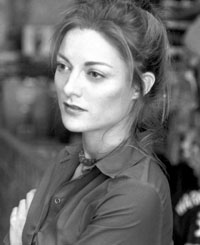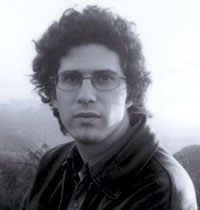25 NEW FACES OF INDEPENDENT FILM 2002
21 Steve Beatrice
SINCE Steve Beatrice began production designing in 1998, he has amassed an impressive string of credits: Karyn Kusama’s Girlfight, Todd Louiso’s Love Liza, Dylan Kidd’s Tribeca-award-winning Roger Dodger and, most recently, Lodge Kerrigan’s upcoming In God’s Hands. He even worked as a "set coordinator" on the tiny crew of the Dogme 95 "no art department" julien donkey-boy, by Harmony Korine. (That’s him standing aside star Ewen Bremner in the widely distributed behind-the-scenes set photo.)
To what does Beatrice attribute his current popularity? "One thing that’s enabled me to move fast through the industry," says Beatrice, "is that when people hire me, they’re hiring someone with six abilities, and that’s helpful when you have a small crew."
But in addition to his jack-of-all-trades skills – he began as a painter at Syracuse, ended as a Film Arts major, and worked as both a scenic painter and art director – Beatrice has a cool artistic eye and is skilled in director diplomacy. "You have to be chameleon-like," says Beatrice of his job. "You are dealing with all these different personalities, and some directors have been living within their pieces for a long time. You are thrown in at the last minute, and you have to get into their world and create a working language."
Whether creating dispassionate interiors that open up into bold reds and greens in the exterior scenes in Love Liza, riffing with d.p. Lisa Rinzler off the paintings of Francis Bacon and Lucien Freud, or "playing with architectural plans, natural light and monochromatic, beige interiors for In God’s Hands, a lot of [my popularity]," Beatrice speculates, "is due to my ability to use everyday spaces and transforming then – taking what is there and making them work." – Scott Macaulay
Contact: Kara Baker-Young, The Gersh Agency (212) 997-1818.
 |
LUCY WALKER was a little girl growing up in London when she saw Peter Weir’s Witness. "I was so intrigued [by the Amish people in the film,]" says Walker. "I thought Hollywood had invented them." Years later, Walker was writing a paper on cultural theory at Oxford. She happened upon an exhibition about quilts and realized that many of the works were by Amish women. "These women are real!" she realized. "I couldn’t figure out why they lived like they did." So, when Walker moved to New York, one of her goals was to learn more about the Amish.
Walker’s obsession paid off in her first feature film, the documentary The Devil’s Playground, which premiered at Sundance 2002 prior to playing on Cinemax. Previously she had attended NYU Graduate Film School and then directed episodes of Nickolodeon’s Blues Clues, for which she was nominated for two Emmy’s. Chronicling the two-year period during which Amish teens experience modern life before committing themselves to the Amish faith, Walker captured shocking and heartbreaking footage of Amish teens grappling with sex, drugs and religious uncertainty. Next up, Walker, who is also a Triathelete, hopes to move into fiction features and has two projects in development. – Scott Macaulay
Contact: Mike Lubin, The Gersh Agency, (212) 997-1818.
 |
"I LIVED in France and Japan for a year each,’ recalls Nicole Cattell, "and realized how little I, as an American, had known about the world. So I decided to use documentary filmmaking specifically as a means to facilitate cross-cultural communication between people in different parts of the world." After earning a Masters degree from the University of Michigan, she found inspiration not too far from her hometown of Ann Arbor in the work of the artist Tyree Guyton.
Come Unto Me: The Faces of Tyree Guyton documents the rise and fall of Guyton’s Heidelberg Project, which transformed a dilapidated street of Detroit’s East Side into an artistic opus with an endless rainbow of paint and a massive treasure chest of household paraphernalia. The Emmy-award-winning film, which aired as part of Cinemax’s "Reel Life" series in 1999, exemplifies Cattell’s interest in art as a mechanism of both understanding and defiance.
"I was drawn to using artwork as a bridge between African Americans in Detroit and white residents in the suburbs," says Cattell. "Tyree was defying what the world would expect from an African-American man growing up in a blighted inner-city neighborhood." His "outsider" art – replete with polka-dotted sidewalks and trees crowned with bundles of old shoes – challenges the aesthetic norms of residential decor and decorum.
Cattell’s latest venture, Revolución, is grounded in her belief in the unique ability of the Cuban photographic art movement to cross political boundaries between "us and them." After three years of development, she will travel to Cuba this summer with d.p. Chuy Chavez (Chuck & Buck, Star Maps) to explore the reaction of four generations of photography to the Cuban Revolution. The film will be shot in Hi-Def 24P thanks to an in-kind services grant she recently won from MoxieDocs.
Cattell’s endeavors are not solely confined to documentaries. She dabbled in ficiton filmmaking, as producer of the upcoming comedy, A Bad Situationist, with Janeane Garofalo and David Cross, and as a narrative screenwriter. Future projects include, "A sea-faring road movie" entitled Mermaid: A Documentary, which will take her back around the world. – Jennifer Manno
Contact: ncattell@nyc.rr.com
 |
"I STARTED as a photographer in high school," says Joshua Marston, "and always wanted to get into filmmaking, but I never had the courage. After two years of being miserable in graduate school studying political science, I finally decided, ‘Fuck it – I’m going to do what I want to do.’ I’d always been interested in inter-cultural stories," he adds, "and I wanted to put these stories on screen, rather than just analyze them."
He enrolled briefly at USC before moving from his native California to attend the graduate film program at NYU.
Marston’s thesis film at NYU, Bus to Queens, is the story of a Russian couple who get stranded very late at night when their train goes out of service in New Jersey, and the only people that can help them get home are two Pakistanis. It was shot in Russian and Punjabi.
Since graduating NYU in 1998, Marston worked on various projects, including a documentary about piano tuners which he describes as "perpetually on hold," when he read an article that would capture his attention and change the course of his life.
"It was about [Colombian] drug mules," Marston recalls, "and the fact that it’s common practice to send a half-dozen people on flights [smuggling drugs], knowing that one or more of them will either die or get arrested."
Marston drafted a screenplay based on the topic, "and immediately decided it didn’t work," he explains, "because it was purely plot. And, I consider myself very much a character-driven, character-oriented, slice-of-life filmmaker."
But he didn’t abandon the project, rather, he began a long process of rewrites that took him to the MacDowell Colony and the Sundance Screenwriting Lab.
"Now, I no longer describe this as a film about drug mules," he says. "It’s a film about a young girl in Colombia who’s frustrated with her circumstances working at a flower plantation, who makes a desperate attempt to escape from those circumstances [by entering] into the world of drug smuggling. It’s a coming-of-age-story that’s very sort of brutal, realistic and honest. It deals as well with the current social and political situation in Colombia, and it also deals with the world of Colombian immigrants in New York and what it’s like to come to a new country and create a new life for oneself."
Producer Paul Mezey, whom Marston solicited through a common acquaintance after seeing Jim McKay’s Our Song, which he felt shared a similar sensibility, eventually signed on to produce Maria Full of Grace. The film shoots six weeks this summer.
"The original intention of the project was that we would go to Colombia – just me, Paul, and the d.p., Jim Denault – and [work with] an entirely Colombian cast and crew." says Marston. "Unfortunately we can’t shoot in Colombia because of the political situation. We’re shooting in Ecuador instead, but we’re doing everything possible to safeguard all that which is Colombian about the project – and part of that is to make sure that everyone who is on screen is actually Colombian."
The film is being co-produced in Colombia by Jaime Osorio, who also worked with Barbet Schroeder on Our Lady of the Assassins, and in NYC by Orlando Tabon, a community leader in Jackson Heights, Queens.
"It’s been incredibly important to me, at every step of the process, to have the Colombian community involved," says Marston, a self-described gringo, "because that’s the best way to make sure that the authenticity, the honesty of the story, is maintained." – Steve Gallagher
Contact: jjmarston@earthlink.net
 |
AT SUNDANCE 2002, amid tepid performance vehicles and movies that mistake low budgets for an excuse for a restrained visual style, Design was a sometimes baffling yet bold and audacious debut. An attempt to craft an American meditation on fate, starring, written and directed by Chicagoan Davidson Cole, it is a film weighted with the powerful influence of Kieslowski, but a Kieslowski without a whisper of God’s grace.
In etching a universe that does not forgive, the film’s daringly dismal bruised-night palette and Cole’s Nic Cage—style unhinged performance might mark Design as an extravagant self-indulgence. But, like Magnolia, a film which shares a love of multicharacter sprawl, Cole did not forget that digressions and strange events are often more compelling than simple plotlines and technical timidity.
In a time of wannabe wunderkinds and kiddie auteurs, the ability to finance and follow through on a breadth of approaches and concerns has to be admired.
Cole also completed his first feature-length documentary, The 95th, in 2001. The film straightforwardly recounts the experiences of U.S. Army veterans who fought under Patton in World War II, returning them to French battlefields for the first time in 55 years. – Ray Pride
Contact: jdigles@mww.com
VOD CALENDAR


 See the VOD Calendar →
See the VOD Calendar →


